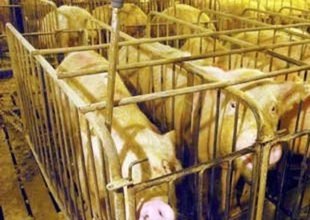Alternet
December 10, 2010
The future of our global food supply is laden with seeds, and most recently animals, modified for human consumption. You may be surprised to see what's on the horizon.

Who would have known 20 years ago that so many of the foods that we eat would be produced in a lab rather than nature? Scientifically designed seeds are becoming a larger than ever portion of our diet and for the most part, it's difficult for the consumer to even realize it because of a lack of labeling. According to Sustainable Table , about 200 million acres of farmland worldwide are now used to grow genetically modified organisms (GMOs). The most common GMO crops are soybeans, which represent 63 percent of all GMO crops, corn at 19 percent, cotton at 13 percent, and canola at 5 percent.
The list of seeds, and later foods that have already been modified also include alfalfa, tomatoes, chicory, flax, papaya, potato, rice, sugar beets, and squash. The future of our global food supply is laden with seeds, and most recently animals, modified for human consumption. You may be surprised to see what's on the horizon.
None of these have been approved yet by the FDA, but with what we've seen so far, who's to say that they won't be in the future.
1. Super Chicken Eggs
New biotechnology is being used to develop genetically modified chickens that produce compounds that can be harvested from the eggs. The compounds in the eggs can be used to fight a range of diseases from diabetes, to viruses to tooth decay, according to Jacqueline Jacob and Richard Miles - Institute of Food and Agricultural Sciences. According to the BBC , UK scientists have developed genetically modified chickens capable of laying eggs containing proteins needed to make cancer-fighting drugs. While these additives may be beneficial on their own, I think most of us would prefer to know what medications and drugs we were taking, rather than getting them in the form of an egg. Let alone all the side effects from feeding people all these extra additives.
2. Non-Browning Apples
According to Food Safety News, Okanagan Specialty Fruits of Summerland, British Columbia, a biotechnology company, has submitted an application to the U.S Department of Agriculture's Animal and Plant Health Inspection Service for market approval for a GMO apple that doesn't brown after being sliced. The apple doesn't brown because the gene that produces the enzyme polyphenol oxidase (what actually turns the apple brown) is silenced. The apples still brown but just not as quickly. What's next, avocados that never go bad and pears that never get brown spots? Crazy stuff.
3. Fast-Growing Salmon
Unless you've been hibernating for the past few months, you've heard about this one and with good reason because salmon would be the first GMO animal approved by the FDA for human consumption.
According to Ars Technica:
These genetically modified Atlantic salmon have two foreign DNA sequences inserted into their genomes. One encodes a growth hormone from Chinook salmon. The other is the on-switch used by an antifreeze gene from ocean pout, an eel-like fish found in the Northwest Atlantic Ocean. When placed alongside the growth hormone, this on-switch makes the salmon produce the growth hormone in cold weather when they otherwise wouldn't. Importantly, the GM salmon do not grow larger than regular salmon; they just achieve their size in sixteen to eighteen months rather than three years.
The FDA isn't evaluating the environmental concerns including pollution, waste, mating, and concentration of disease that go along with Aqua Bounty's approval, just whether it's safe for human consumption and it's way too early to know that either.
4. Hyper-Producing Seeds
Scientists are working to manipulate DNA to create hyper-producing seeds, specifically plum tomato seeds that increase the yield by half. Zachary Lippman and his team at Cold Spring Harbor Laboratory, produced a strain of hyper-productive tomato seeds by altering the command gene that tells plants when and how many flowers to generate, according to the New York Times. He's also thinking about the modification in melons and soybeans.
5. Enviro-Pigs
Christine over at TreeHugger wrote that Canada has approved limited production of animals dubbed "enviropigs™," pigs that are modified to produce 65 percent less phosphorous in their poop and urine. Pig farms are notorious for producing a world of waste, three times more excrement than human beings do. Lloyd wrote about a Rolling Stone article entitled Pork's Dirty Little Secret which reported that an estimated 500,000 pigs at a subsidiary of pork giant Smithfield generate more fecal matter each year than the 1.5 million inhabitants of Manhattan.The stream of waste is loaded with phosphorus which causes the growth of excessive algae in lakes and streams which in turn, sucks the oxygen out of water and kills off all life. But even still, scientifically altering a pig so that it's less polluting seems counterintuitive to me.






Leave a comment